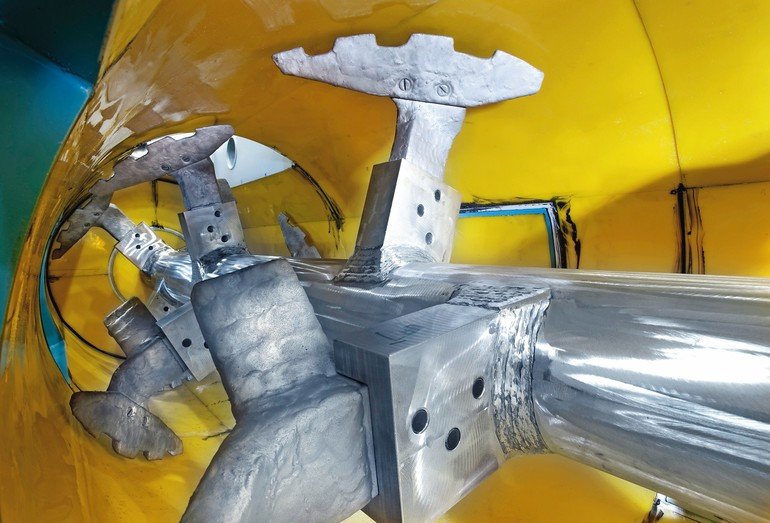When searching for the ideal implementation of a mixing application, the mixed product is always the first consideration. It is crucial to have accurate and extensive information on this product, and to base every detail of the development on this. However, products frequently have specific properties which exceed the limits of customary vertical or horizontal mixing systems. Materials with a tendency to cure are just one example.
Rapidly bonding materials
Examples of rapidly bonding materials can be found in many different fields and sectors of industry: hardening ashes and ash dusts from combustion plants containing a high percentage of calcium oxide (CaO) are among them. This is due to the tendency of CaO to react with water. Sludges from production processes may also react with additives, causing them to harden. Similarly, residual sludges have a tendency to harden, for instance, if they are mixed with cement to obtain a stable product that is suitable for disposal in a landfill.
What many of these materials have in common is that they are treated in one manner or another, either to facilitate further processing or – even more commonly – to enable efficient disposal. Amongst other things, they are hardened and stabilised in the presence of additives or an exhaustive reaction. This conditioning takes place in a mixer. In a continuous process, the materials intended for treatment are fed into the mixer, either from a silo where bulk materials are involved or from filter presses in the case of sludges. The product to be mixed passes through the mixing vessel in a precisely defined way and is then automatically processed further.
Only one problem remains: when treating or conditioning powdery or pasty materials, setting or bonding – or both – may occur depending on the type of added components. The properties deliberately changed by the process can then cause significant problems in the mixer, depending on the degree of hardening. One frequently encountered phenomenon is the adherence of hardened materials to the mixer’s inner wall. These adhering materials can lead to oscillation and vibration in connection with severe noise emission, for instance loud “rattling”.
Moreover, the hardened materials result in increased wear on the mixing tools circulating within the drum. The design of the mixing tool peripherals can only partially counteract these negative effects of material adherence.
Linings for the inner wall
To solve these problems, Lödige developed a number of different linings especially for the continuous ploughshare mixer. Linings made of rubber, polyurethane, polyethylene, PTFE or other materials can be used depending on the product properties. Together with the Lödige mixing principle and the ideal Froude number, these options provide an ideal combination for bonding materials with traditionally difficult properties. These measures prevent the formation of hardened layers, which could adhere permanently to the inner wall of the mixing vessel. However, if hardened layers are formed nevertheless by materials adhering during the mixing process, the pressure of the mixing tools against these layers increases. The surface properties of the plastics cause the layers to be subjected to radial and axial movements or deformed due to low elasticity (rubber), so that cracking occurs. The cracks grow with each circulation of the ploughshare shovels, until the layers finally get away from the wall and re-enter the mixing vessel. This process is repeated continuously. The mixing system can be used to treat materials for which conventional mixers are unsuitable. It is available in several different sizes up to a maximum throughput of 1000 t/h.
Easy inspection of mixer components
Lödige puts particular emphasis on the simplest possible replacement of wear-prone and high-maintenance mixer components. For this reason, a mixing vessel design with divisions across the entire length is offered in addition to the version with lateral inspection doors. This solution permits unimpeded access to the entire mixer interior, for quick detection of the condition of wear parts and, if necessary, replacement with only minimal downtime, ensuring that the system is soon up and running again. The plastic lining can even be replaced directly on the system.
Lödige
Hall 6.0, Booth C2








